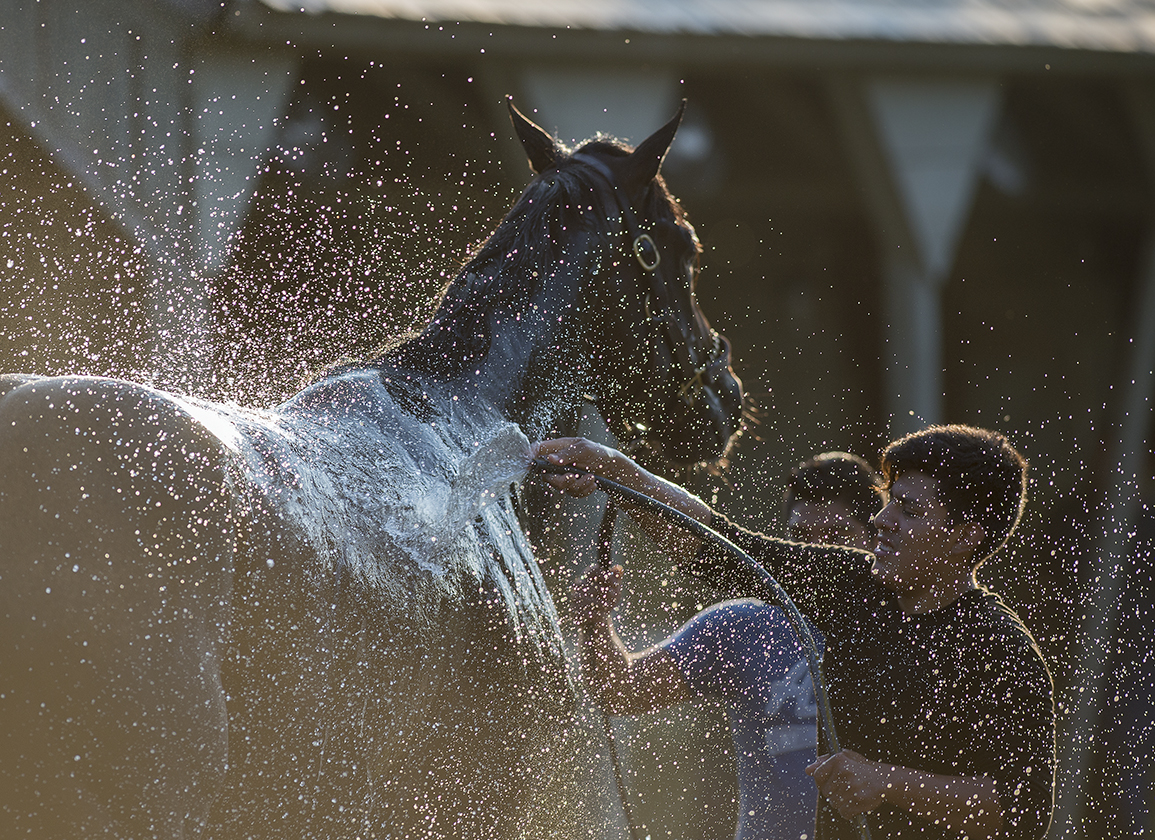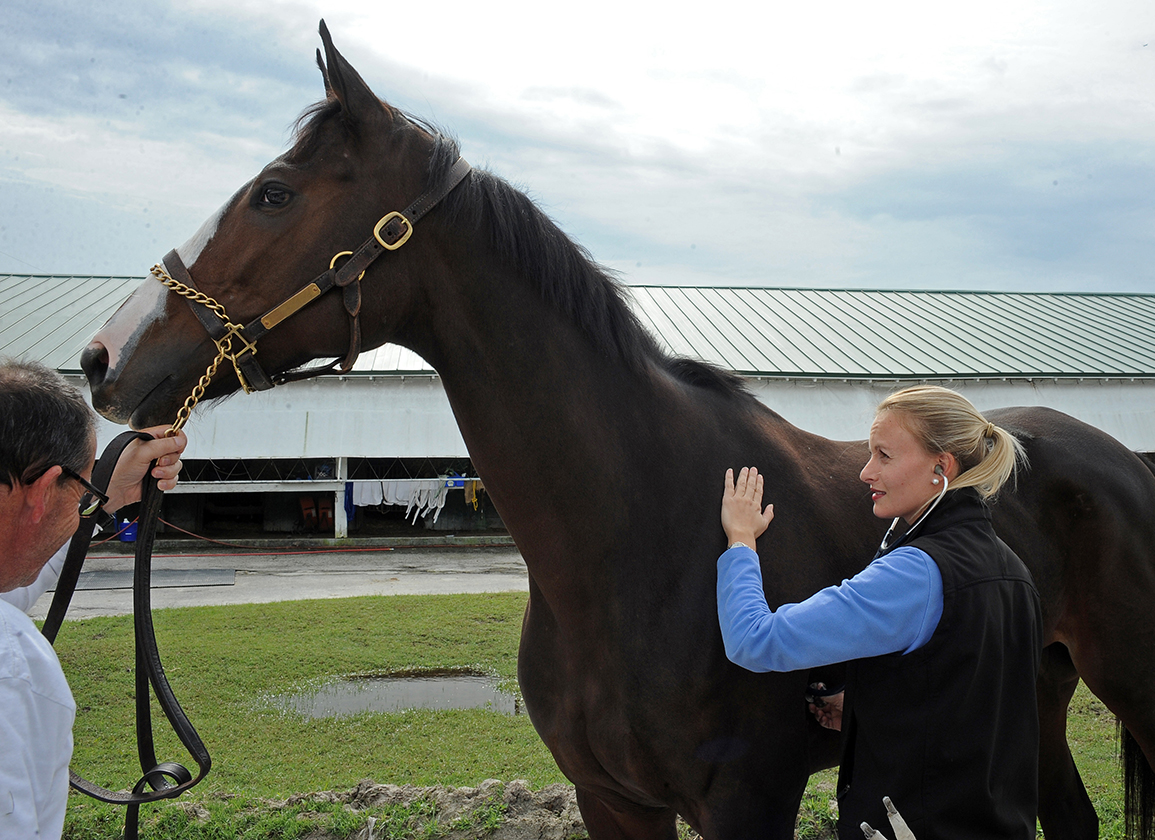We recently ran part one of our story on the challenges facing HISA. Today, we deal with lawsuits, adjudication, and more.
This time next year, the machinery of horse racing in the U.S. may be almost a month into a radical system overhaul.
But with scant few calendar pages between now and then, what do we know about how the cogs, wheels, and pulleys of the Horseracing Integrity and Safety Act (HISA) will work together?
To find out, the TDN reached out to Charles Scheeler, chair of the HISA board of directors, interim executive director Hank Zeitlin, as well as several individuals listed on HISA's two standing committees. All explained that they were unable to comment publicly at present.
U.S. Anti-Doping Agency (USADA) chief executive officer Travis Tygart was also unable to speak in person within time of the story going to print, but the agency provided answers via email.
Figures familiar with the drafting process stress the changing nature of the blueprints–cold comfort to certain state regulators and other stakeholders concerned that with so many details to thrash out, few specifics have yet been made public, especially when crucial deadlines loom large, as we detailed yesterday in part one.
In part two, we try to parse through other key aspects of the program, beginning with arguably the most salient, given recent high-profile cases in the U.S.–that of enforcement.
Lawsuits
All of these points could be moot, however, if either of the two federal lawsuits seeking to strike the law down on constitutional grounds are successful.
In March, the National Horsemen's Benevolent and Protective Association (National HBPA)–along with a variety of state affiliates–filed federal suit against the Federal Trade Commission (FTC), arguing that it affords powers to private individuals and a private organization in an area strictly limited to a government entity.
The following month, it was announced that a second lawsuit–spearheaded by the Oklahoma Attorney General in conjunction with that state's racing commission–was similarly focused on the constitutionality of the law, focusing in on the 10th amendment.
Judicial rulings are essentially pending in both cases.

Sarah Andrew
According to Frank Becker, a noted equine lawyer and former adjunct professor at the University of Kentucky College of Law, the “Oklahoma” case has a “significant chance” of prevailing.
“But what happens at the district court level will not be the final word–it's really going to be up to the court of appeals,” Becker says, speculating that either case could eventually be taken up by the Supreme Court.
If the district courts render rulings against the defendants, what might that mean for HISA's implementation on July 1 next year?
“While this case is pending, there will be this battle over whether the law will be enforceable in the interim,” says Becker, itemizing a chessboard set of scenarios made complicated by the possibility of inconsistent rulings by different courts in two different circuits.
One is that an injunction goes into immediate effect, in which case, the law would be put on the back burner until an appeals court meters out judgment–if, as would be likely, the government appeals the district court's decision.
Another is that a district court judge renders a stay on the injunction pending appeal. In this scenario, the appeal is “unlikely” to occur before the July 1 deadline, Becker says, meaning the law would theoretically go into effect.
Nevertheless, nothing is etched in stone.
Becker pointed to a potential precedent-setting scenario in a current case involving the cruise ship industry and the Centers for Disease Control and Prevention (CDC) in which the judge granted a stay on an injunction, only to subsequently withdraw it. And so, “anything could happen,” says Becker.
If the case reaches the hallowed halls of the U.S. Supreme Court, a final decision “could take years,” says Becker.
“But again, you've got the issue of, if there's an injunction in place when it goes to the Supreme Court, the Supreme Court would [likely] be asked to lift the injunction pending a decision,” says Becker. And how it might decide, he adds, “is very hard to predict.”
For the purposes of the story, however, we'll take the view the law will already be functioning a year from today.
Adjudication Process
HISA's enforcement agency serves several vital purposes, from establishing a deterrence program to implementing “anti-doping education, research, testing, compliance and adjudication,” among other duties.

Racing Post
But first, who will the Horseracing Integrity and Safety Authority–the broad non-profit umbrella established by HISA and commonly referred to as just the “Authority”–contract with to serve this purpose?
The Authority is largely expected to enter into an agreement with USADA, but the contract hasn't yet been formally inked. Indeed, according to USADA spokesperson Adam Woullard, the agency is working through the details with the Authority, “in anticipation of signing” a contract.
If, for some reason, USADA is not the contracted enforcement agency, the law instructs the Authority to enter into an agreement “with an entity that is nationally recognized as being a medication regulation agency equal in qualification” to USADA–conceivably individual state commissions.
In terms of the enforcement agency's broad remit, the processing of violations sits high on the priority list.
But which specific set of personnel will be responsible for adjudicating the first drug-related violations that arrive after July 1 next year–those belonging to the existing regulatory infrastructures within individual states or those belonging to USADA, or the contracted enforcement agency?
Specifics remain unclear. According to Woullard, USADA would “independently handle” the “investigation and results management” arm of the program.
“Independence is the cornerstone of any effective and fair anti-doping program,” he wrote. “Complementing this, education is paramount in creating a cohesive program and we look forward to working with those within the industry to help them understand and comply with the rules.”
Asked what the adjudication process might look like on a practical, everyday basis, Woullard replied that “the exact nature of how this will look is a work in progress.”
It appears, according to several individuals familiar with the process, that a tiered approach could be taken to the adjudication of medication violations, with the severity of the infraction governing which set of personnel–either the state's or USADA's–will handle the hearing.
“Extra importance could be attached to certain races and horses,” says Bill Lear, The Jockey Club (TJC) vice chairman and someone instrumental in getting the legislation passed.

Coady
Appeals
Once a violation has been adjudicated, a notice of the sanction will be filed with the FTC. The sanctioned party then has 30 days to petition for a review of the decision, which will be handled by an administrative law judge within the FTC. That judge then has 60 days to issue a ruling.
A number of stakeholders contacted for the story questioned whether the FTC has the necessary human capacity and experience to handle its expanded obligations under HISA.
“How quickly do rules and hearings move through the federal pipeline?” says Bennett Liebman, government lawyer in residence for the Albany Law School's Government Law Center.
Liebman has previously written of the FTC that it has “much bigger business to pursue than just racing,” and that it “enforces many more laws of greater consequence to the American economy than horse racing regulation.”
The FTC failed to provide a response to questions about the steps the agency has taken to prepare for HISA's implementation.
But according to Lear, the FTC has been “very engaged” with defending the two federal lawsuits challenging the constitutionality of the law.
Safety Committee
In tandem with the Anti-Doping and Medication Control Standing Committee, the Racetrack Safety Standing Committee will be responsible for establishing a uniform set of rules governing things like training and racing safety protocols that are regionally specific, crop use, racetrack surface quality standards, and a racetrack accreditation program.
What could those safety standards look like?
The safety committee is required to consider as a blueprint existing programs like the National Thoroughbred Racing Association (NTRA)'s Safety and Integrity Alliance Code of Standards, along with other comparable international programs.
“You won't see much of a sea change in most of racing,” says Alex Waldrop, president and CEO of the NTRA, pointing to tracks and jurisdictions like those in Kentucky, California, New York, and across the Mid-Atlantic region, which have in recent years implemented their own significant plans to reduce equine fatalities.
“But there are multiple states where that has not been the case,” says Waldrop.
Nevertheless, the safety measures even among the more proactive tracks and jurisdictions can vary quite significantly, and there's apprehension among respective stakeholders that the Authority's uniform safety standards won't have the same bite.
“We're pretty proud of the work we've been doing here, and we don't want to see that rolled back in any way,” says Scott Chaney, executive director of the California Horse Racing Board (CHRB), pointing to the immense political headwinds the state industry has had to withstand in recent years.

Susie Raisher
Unlike the baseline medication standards, however, the law appears to provide a certain amount of individual wriggle room in the implementation of safety and welfare protocols.
According to Lear, individual tracks–but not individual states–will have the leverage to implement stricter safety standards than that outlined by the Authority.
“That said, I think HISA is going to make every effort to work with the states to create a good working relationship, and one that doesn't back up on any safety standards,” Lear says.
State racing commissions aren't expected to be rendered redundant under the new law–indeed, the Authority will likely contract state racing commissions to enforce components of the racetrack safety program.
But whether individual tracks decide to tighten their own safety standards and protocols or not, those in charge of nailing down the specifics of the safety program have the sizeable problem of wrestling with this central question, says Liebman: Which entity, the individual state commission or the federal Authority, has exactly what responsibility?
“Do racing commissions still have the power to punish riders for improper whip use?” he says. “Who will have the power to scratch a horse for medical or welfare reasons?”
Funding Concerns
Some of the touted benefits of the new law concern improvement in racing's overall intelligence infrastructure, including greater out-of-competition testing and a more comprehensive investigatory network.
HISA also calls for the implementation of a centralized database for a variety of potential key information points, including injury and fatality data, pre- and post-training and race inspections, and inclusion on a veterinarian's list.

Coady
“We'll be able to better follow these horses wherever they are on a daily basis–we'll know what they look like a week ago, a month ago, a year ago,” says Waldrop.
But undergirding the successful implementation of any of these measures is the issue of funding–what almost everyone contacted for this story described as something of an elephant in the room.
The language of the law outlines two broad scenarios–that individual racing commissions establish a mechanism to remit fees to the Authority, or else the racing commissions permit the Authority to assess the fees for them.
How will the fees be calculated?
If a state elects to collect and remit the fees itself, it may consider “foal registration fees, sales contributions, starter fees, track fees, and other fees on covered persons,” wrote Sarah Reeves, attorney with the firm Stoll Keenon Ogden and someone who has worked extensively on building the legal architecture of the law, in an email.
If a state chooses to delegate this task, then the Authority would calculate, “on a monthly basis,” the applicable fee per racing start multiplied by the number of racing starts in the state in the preceding month, wrote Reeves.
She wrote that in the latter event, it is too early to say exactly how the Authority would decide to collect the fees, “whether on a per-start fee basis or otherwise.”
Reeves noted, however, that the law precludes a double tax. “If a state chooses not to collect fees to cover the costs of the Authority in that state, the statute precludes the state from charging members of the Thoroughbred industry any fees or taxes related to anti-doping and medication control or racetrack safety,” she wrote.
As it stands, no specific budget proposals have been publicly aired. And until more specifics are made available, states are largely hamstrung as to which fee remittance route to take, multiple stakeholders told the TDN.
What's more, like a Sword of Damocles, numerous states around the county are already embroiled in budget negotiations for the next fiscal year or two–like in Wyoming, currently in the process of thrashing out their 2022-23 biennial budget, says Charles Moore, the Wyoming Gaming Commission's executive director.
“Here we are going into a budget session and we don't know what to expect–will there be a cost, and if so, what will it be? What is the net effect?” Moore says.

Coady
The longer budget details take to concretize, the more likely are individual states to punt broader everyday responsibilities over to USADA, certain stakeholders warn.
In that scenario, does USADA have enough personnel to manage a larger-than-anticipated workload?
In answer, Woullard pointed to a recent hire in Dr. Tessa Muir, newly minted director of their Equine Testing Program.
“We will continue to recruit experts in the field and train our existing staff for the huge responsibility ahead of us,” Woullard wrote, adding that while USADA will hire additional personnel, including those with equine-specific expertise, “There is significant overlap in several areas of equine and human anti-doping, particularly in relation to doping practices, test planning and risk analysis.”
Lear, however, argues that “HISA is working hard to zero in costs,” and adds that, while “the principal driver of added costs is in out-of-competition testing,” federal consolidation and centralization will bring about efficiencies through economies of scale.
What's Next
In the meantime, some much sought-after details about the Authority could soon be available for public consumption.
On Aug. 15 at The Jockey Club's next annual Round Table Conference, Scheeler is expected to give his first public presentations on developments thus far.
According to USADA spokesperson Woullard, Tygart and Muir have also been invited to appear at the round table event.
If there's an overarching sentiment among industry stakeholders wondering how HISA will fit into their everyday operations, it's centered around caution and circumspection.
“From my own perspective, they ought to be as practical as possible getting started,” says Alan Foreman, chairman and CEO of the Thoroughbred Horsemen's Association (THA). “They're going to have to build confidence in the whole process as it's such a dramatic change.”

The post What Will HISA Look Like? appeared first on TDN | Thoroughbred Daily News | Horse Racing News, Results and Video | Thoroughbred Breeding and Auctions.
Source of original post






